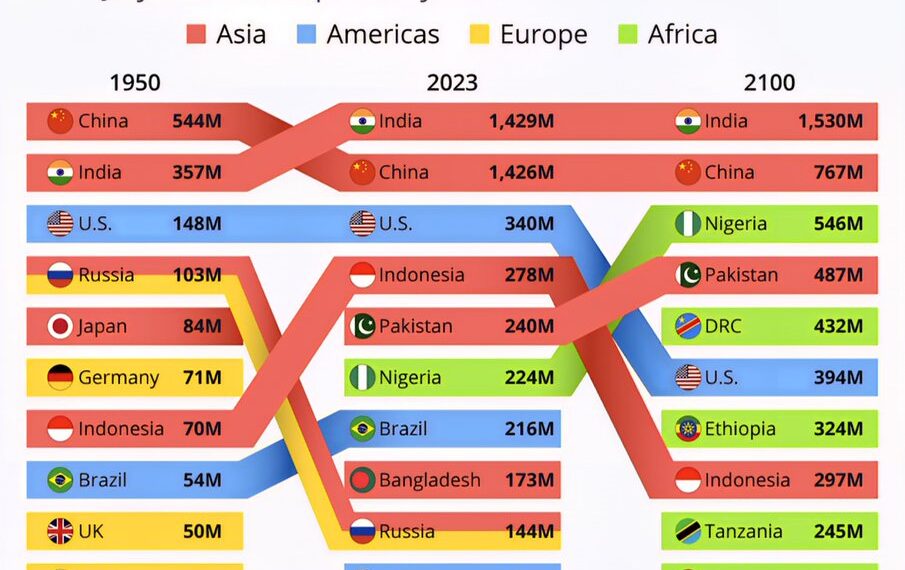Select Language:
The Most Populous Countries in the World in 2025

1. China: The Population Powerhouse
China continues to hold the title as the most populous country in the world, boasting over 1.45 billion residents in 2025. Despite recent efforts to curb population growth through family planning policies, the country’s population remains immense. Urbanization trends have accelerated, especially in megacities like Shanghai and Beijing, which are home to millions of residents each. China’s demographic shifts, including an aging population and declining birth rates, pose long-term challenges for its economic growth and social services. The government now emphasizes policies supporting family expansion and elder care to address these issues.
2. India: Rapid Growth and Demographic Changes
India has firmly established itself as the second most populous country, with populations surpassing 1.43 billion in 2025. Its population growth rate has slowed compared to previous decades but remains significant. Urban centers like Delhi, Mumbai, and Bangalore continue to expand rapidly, driven by rural-to-urban migration and higher birth rates in some regions. India is facing a socio-economic balancing act: while a youthful workforce drives economic development, the country must also navigate challenges related to healthcare, infrastructure, and resource management that come with such rapid population expansion.
3. United States: The Diverse Demographic Landscape
The U.S. remains the third most populous country, with an estimated population of around 340 million in 2025. The American population is becoming increasingly diverse due to ongoing immigration and higher birth rates among certain ethnic groups. Major metropolitan areas such as New York City, Los Angeles, and Houston are continuously growing, resulting in vibrant cultural melting pots. Despite a relatively stable population growth trend, the U.S. faces regional disparities and infrastructure challenges associated with urban sprawl and aging infrastructure. Efforts are underway to promote sustainable urban development and immigration policies to support future growth.
4. Indonesia: Southeast Asia’s Largest Population
Indonesia, with a population exceeding 330 million, is Southeast Asia’s most populous country by a significant margin. The nation continues to experience steady population growth, especially on Java, which remains its most densely populated island. Indonesia’s youthful demographic presents both opportunities and challenges—such as providing education and employment—while also addressing health and environmental issues stemming from population density. The government prioritizes development programs aimed at decentralizing growth and improving rural infrastructure.
5. Pakistan: Rapid Expansion and Urbanization
Pakistan’s population is estimated to be approximately 230 million, making it the fifth most populous country. The country’s population growth remains high, particularly in urban centers like Karachi and Lahore. Rapid urbanization has led to overcrowded cities and strain on infrastructure, health services, and housing. Food security and water resources are increasingly stretched thin, highlighting the urgency for sustainable development initiatives. Pakistan is focusing on improving education and health systems to better serve its expanding population.
6. Nigeria: Africa’s Population Leader
Nigeria continues on its upward demographic trajectory, with over 225 million people, positioning it as the most populous country in Africa in 2025. A high birth rate and decreasing mortality rates have contributed to rapid population growth. Nigeria’s youthful population—more than 60% under 25—offers a potential demographic dividend but also poses challenges in employment, healthcare, and education. Urban centers like Lagos are burgeoning into massive metropolises, requiring innovative solutions for sustainable urban planning and infrastructure development.
7. Brazil: South America’s Most Populous Nation
Brazil rounds out the top seven with approximately 220 million inhabitants. Its population growth has slowed significantly over the past decade, primarily due to declining birth rates. Major cities like São Paulo and Rio de Janeiro remain economic and cultural hubs, yet they face issues of urban inequality, pollution, and transportation congestion. Brazil’s government is actively working on policies to manage urban growth sustainably while improving public health and education systems.
8. Bangladesh: Dense and Dynamic
With around 170 million residents, Bangladesh remains one of the world’s most densely populated countries. Its population continues to grow steadily, especially in rural areas transitioning toward urbanization. Dhaka, the capital, ranks among the most crowded cities worldwide, emphasizing the need for improved infrastructure, disaster management, and environmental conservation. The country is also focusing on economic development and poverty alleviation to support its rapidly increasing population.
9. Russia: Declining Population, Aging Demographics
Russia’s population is estimated at about 144 million in 2025. The country faces long-term demographic challenges, including population decline, low birth rates, and an aging population. Moscow and St. Petersburg remain the largest urban centers, but many regions are experiencing depopulation. Russia is implementing incentives to boost fertility rates and attract immigrants to counteract demographic decline, but recovery efforts will take time.
10. Mexico: North America’s Latin Powerhouse
With approximately 130 million people, Mexico rounding out the top ten most populous countries. The nation’s population growth has moderated, yet Mexico continues to experience urban expansion, especially in Mexico City and surrounding metropolitan areas. Issues such as urban congestion, pollution, and social inequality are at the forefront of Mexico’s development agenda. Encouraging rural development and sustainable urban planning are key to managing future demographic shifts.
The world’s population landscape is continually changing, influenced by social, economic, and environmental factors. Policymakers in these countries are tasked with balancing growth with sustainability to ensure a stable future for their citizens.






